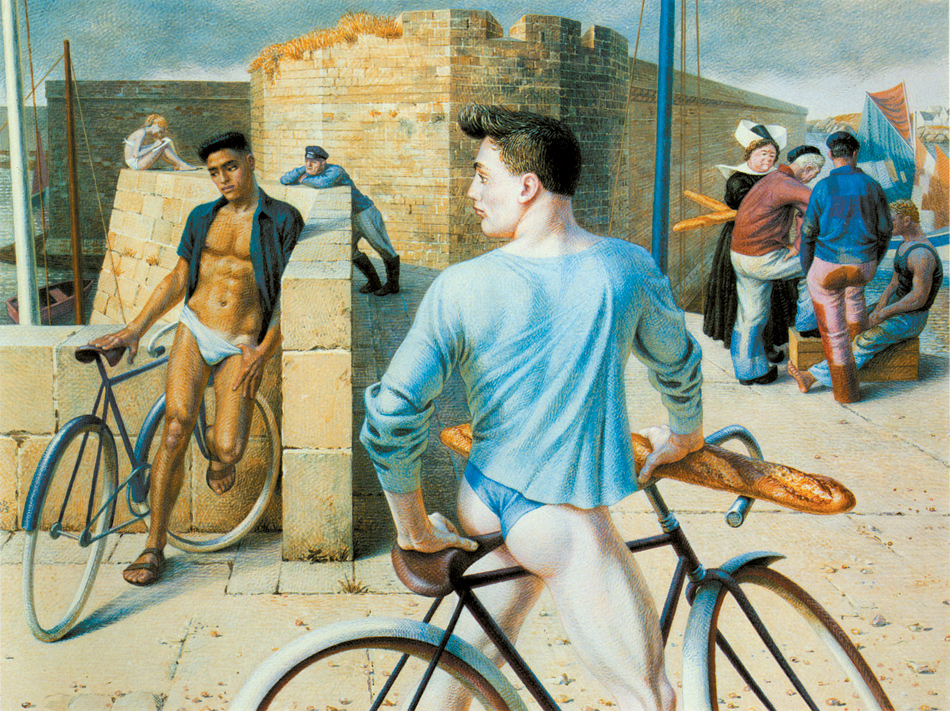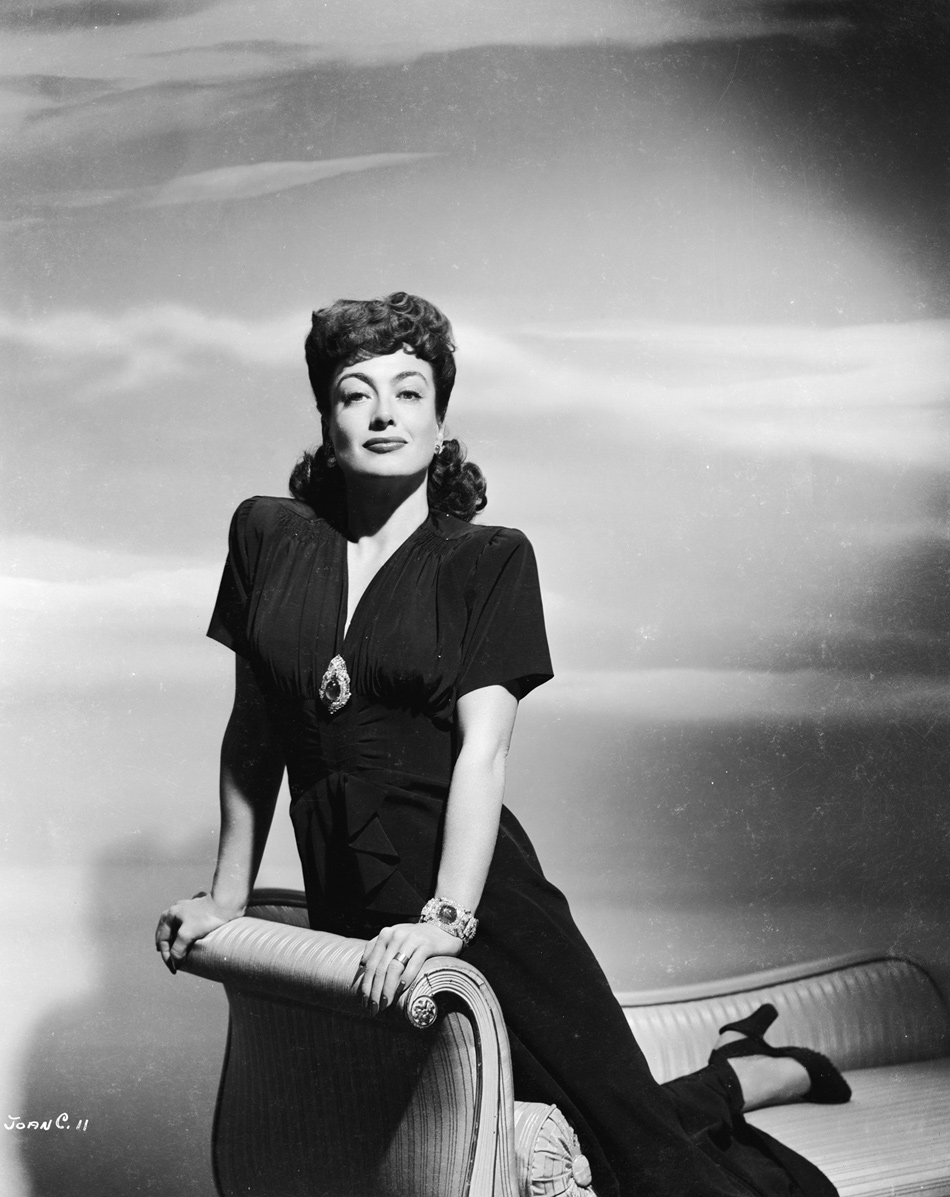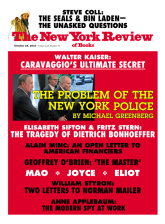When I was an undergraduate at the University of Michigan in the early 1960s I used to gather some of my fellow students into sessions held on the balcony of the Pancake Palace. There, as we chatted, I would in effect teach them how to camp—how to reverse genders systematically, how to drop hints one was gay (called “dropping beads”), how to refer to oneself (as Auden does in a poem) as “Miss Me” or “Your Mother” (Auden was once confused with Robert Frost in the club car to New Haven by a Yale undergraduate who sent him a note via a waiter; he passed back a note that read, ”You’ve spoiled Mother’s day”), how to label a guy who likes blacks (“a dinge queen”) or Asians (“a rice queen”) or what to call an Asian who likes white men (“a potato queen”). Because I’d hung out in Chicago’s gay coffee shops at Clark and Diversey I knew more than the other gay boys in my playwriting seminar. I knew that someone who liked well-hung men was “a size queen,” just as someone with a small penis was “Princess Pencil Meat.”
David M. Halperin, who coincidentally is the W.H. Auden Distinguished University Professor of the History and Theory of Sexuality at the University of Michigan, starts with the idea that homosexual sexual experience is no guarantee that one is initiated into any larger sense of gay culture. It must, he argues, be learned from older or at least more savvy gays or somehow intuited on one’s own. Some straights are imbued with the gay sensibility, just as many homosexuals reject or don’t know about gay culture; those married men at the baths may be completely clueless and want to stay that way. The South African and German men in the first part of Damon Galgut’s wonderful, mysterious novel In a Strange Room are attracted to each other but would never describe themselves as “gay.”
Paradoxically, since gay men rarely have gay parents, cultural transmission must come from friends or strangers (a problem since the generations so seldom mix in gay life). Another oddity is that the more one knows about gay culture (Broadway musicals, home decorating, the lingo), the less attractive one is to most gay men, who are generally looking for a bona fide macho man. Gay culture must be the only one that esteems precisely those who aren’t initiated. Imagine a devout Jew who rejected someone who knew the Torah.
Whereas Halperin acknowledges that most young gays today disavow gay culture and say they have no need of it, nevertheless it continues to exert a strong appeal. When he taught a course called “How To Be Gay,” it attracted many straight and gay undergraduates and caused a scandal; it not only raised the question of what sort of university offered such a course but was taken to mean that Michigan taxpayers were bankrolling a recruitment project. The right-wing press had a field day; one publication showed a cartoon of a nerdy professor saying, “Class, repeat after me: ‘What a dump!’” Halperin quite unimaginatively felt the cartoon must have been intended for gay readers since only they would recognize Bette Davis’s famous line from an obscure film, Beyond the Forest.
His argument in his repetitious but ingenious book seems to be that gays respond to Hollywood films and old musicals, which are part of mainstream culture, more than to novels or plays written by gays for gays. Although Halperin admits that some post-Stonewall gays pretend to esteem books written for them, they would, he believe, prefer to decode and recode mainstream TV shows. As he puts it, “Why would we want Edmund White, when we still have The Golden Girls?” No doubt some would. But surely the opportunity that novelists of my generation had to explore the previously uncharted territory of gay life, and to write about gay consciousness, was too much of a temptation to ignore, and our efforts to map out gay experience revealed a part of the culture that had been largely hidden.
But Halperin feels that gay men are not interested in identity (what gay fiction may provide) but in identification with strong but vulnerable women (Judy Garland or Joan Crawford or, to be more up-to-date, Lady Gaga). They want to be able to transpose the tensions they observe on screen or on the stage into more personal, private experience. But he is opposed to psychological, certainly psychoanalytic analysis; he prefers what he calls “the poetics of culture.” In his view, “gay identity does a very bad job of capturing what it feels like to be gay, because it fails to translate into expressive form the full extent and range of gay desire.” Elsewhere he writes, “Gay men routinely cherish non-gay artifacts and cultural forms that realize gay desire instead of denoting it.”
Advertisement
Drawing on the work of the Berkeley film critic D.A. Miller, he quotes with approval Miller’s idea that the potentially gay little boy loves Broadway musicals but realizes they stand for “the solitude, shame, secretiveness by which the impossibility of social integration was first internalized.” What Halperin chooses to study, however, at great length and with Jesuitical ingenuity, is not Barbra Streisand’s Funny Girl but a few frames in the old Joan Crawford movie Mildred Pierce, not because he asserts that gay men today are so drawn to it, but because he wants to analyze its undeniable appeal to gay audiences over the years.
He zeroes in on the scene where Crawford has a confrontation with her spoiled daughter Veda, played by Ann Blyth. When Veda admits that she blackmailed her ex-fiancé into falsely thinking she is pregnant and paying her off to make the problem go away, she says she wanted the money so she could escape from her plebeian mother. Mildred announces: “Veda, I think I’m really seeing you for the first time in my life, and you’re cheap and horrible.” She tears up the check that represents Veda’s getaway money. Veda slaps her mother, who says: “Get out before I kill you.”
Halperin is quick to admit that gay audiences take this melodramatic scene as camp, but he is, to say the least, throughgoing in his discussion of camp. He points out that “kitsch” (the usual translation of “camp” in German and French) makes fun of someone else’s taste, whereas “camp” ridicules one’s own taste. He states, “Camp works to drain suffering that it also does not deny.” He adds: “When you make fun of your own pain, you anticipate and preempt the devaluation of it by others.” Whereas he finds that the bad things that happen to adult heterosexual men are seen as tragic and universal, those that happen to women and gay men are dismissed as trivial and melodramatic. Everything camp is happening between inverted commas: “To perceive Camp in objects and persons is to understand Being-as-Playing-a Role.”
Although Halperin makes coherent points most of the time, occasionally he seems delirious: “In order to get to the bottom of the mystery of homosexual attraction, you have to focus your attention on the object of your desire in its most complete contextual realization, its full social concreteness, its specific social systematicity.” Here one thinks of Jane Austen’s remark: “For it is extraordinarily difficult to say foolishness clearly without exposing it for what it is.”
To return to Mildred Pierce (as Halperin does again and again), he speculates that the scene with Veda appeals to gay men because their greatest fear is that they will be rejected by their adored mothers for being…queer. Movies like Mildred Pierce and Mommie Dearest are telling for many gay men because
the pleasure that gay male culture takes in appropriating those films reflects the ironic attitude gay men had long cultivated in order to distance and thereby insulate themselves from the hurtful histrionics of family life—without, however, denying the deadly earnestness of those histrionics.
What’s more, Mildred Pierce, in Halpern’s view, not only expresses a gay boy’s fear of disappointing and alienating Mommie, it also inoculates him against disappointment in romantic love. Or as he puts it:
Gay male culture’s investment in the scene of mother-daughter conflict may well have to do, in other words, with the unfavorable social and discursive conditions under which gay men accede to the possibility of emotional expression, and of erotic expression most of all. It may have to do, specifically, both with the powerful, sinister lure of romanticism to gay men and with the cure for romanticism that the gay celebration of inauthenticity affords.
I think most gays would say that Halperin is making too much of all this. While it’s probably true that gays used to admire strong but vulnerable women and that it’s fun to see a perfectly coiffed and dressed movie star overact and approximate a drag queen’s worst, most malicious “scenes” (the original meaning of “to camp it up”), I think to go from there to fear of Mommy’s rejection and of a lover’s indifference is stretching things. As Halperin elaborates:
What started out looking like a particular obsession on the part of gay men with the figure of the mother turns out to have more to do with gay men’s fraught relation to the dangerously seductive, oppressive, inescapable, helpless, would-be tragic role of the romantic lover.
Notice how the innocent-seeming “turns out” leads us to his questionable conclusion, which he nails down with an overkill of adjectives. Later he claims that gays are “disabused but not disenchanted” with love.
Advertisement
It’s hard to know which gays he’s referring to. Most of the really long-term couples I know are gay, and gays seem more truly eager to get married these days than most others. He would probably dismiss me as part of the Stonewall generation who are so out of touch with the eternal verities of Mommie Dearest; he seems to think older gays are incapable of understanding him.
Although he repeatedly eschews “ego psychology,” most of his strategies for analyzing gay culture derive from Freud’s analysis of dreams, including displacement, symbolism, black-for-white reversals, condensation, screen memories, and so on. And where, pray tell, do these processes take place except in a person’s mind? I’m just as hostile to psychoanalysis as Halperin, especially for its harmful mission to “cure” gays. Its conclusions are as dubious as his—but he should acknowledge the influence of psychoanalysis on his thinking.
Halperin argues that gay culture does perpetuate itself. He writes:
Despite the widely held conviction that gay male culture is constantly going out of date, it turns out to have changed a lot less over time than we like to claim. Gay liberation has actually not been all that successful in its efforts to remake the subjective lives of gay men. It has not managed to install gay politicians or sports figures in the place of female divas, nor has it ended the cultural valorization of taste or style—even if gay fashions have evolved since the 1950s. Gay men have not stopped finding gay meaning in female icons, from The Golden Girls to Desperate Housewives to Lady Gaga.
Once again “turns out” introduces a questionable series of conclusions.
But how do pregay kids discover gay culture? They don’t usually learn about it from older gays, as was the case in the University of Michigan restaurant. I once participated in a strange panel discussion in London at the Institute for Contemporary Art on “pricking thumbs” (derived from the witch’s verse in Macbeth that “by the pricking of my thumbs” you shall know when you’re in the presence of “elves and fairies”). Did we as children feel drawn to artistic figures we later discovered were gay? I claimed that as a little child I was drawn to the actor Jean-Pierre Aumont, who was cast by Truffaut as a gay man in Day for Night (La nuit américaine); to be sure, in real life he had four marriages and sired two children.
Several people on the panel mentioned Tchaikovsky as a precocious enthusiasm as well as Barbara Stanwyck. Halperin quotes with approval a remark by Barry Adam: “Musical theater is one of a number of possibilities that speak to the sense of difference, desire to escape, and will to imagine alternatives that seems a widespread childhood experience of many pregay boys.” The Belgian film My Life in Pink is about a cross-dressing transgender gay boy who lives in a fantasy world with “Pam,” a transgender doll much like Barbie.
Halperin makes a bold assertion: “So I can claim to have put forward a conceptual model for understanding the social process of acculturation by which a gay male sensibility is formed.” One nagging trouble with discussing a gay male sensibility—or any sensibility at all—is that we would feel uncomfortable referring to a “black sensibility” or a “Jewish sensibility.” When a sensibility is attributed to a group it sounds like a prejudice. Again and again Halperin reminds of how insaisissable or elusive is gay sensibility or style, though he is certain that he has captured this butterfly. He is trying to analyze why a one-second sequence of his beloved Mildred Pierce is so “heart-stopping”—the moment when Joan Crawford walks through the shadows cast by Venetian blinds as she heads for a confrontation with her erstwhile lover, the cad Monte, played by Zachary Scott. According to Halperin the scene says to the spectator something like “Get ready for Joan. She’s a-coming. She’s on her way. Watch out—here we go!”
Halperin takes up the question of why gay men identify with women (if they do). Feminists used to claim that camp was a form of satire and functioned as a put-down of the women it was supposedly worshiping but actually ridiculing. Halperin thinks that camp is like what Warhol said of Pop Art: “It’s a way of liking things.” But he also makes a more radical claim:
This instance of gay male feminine identification, then, actually expresses neither an underlying female nature nor a masculine one, nor something in between. Rather, it expresses something else—something specifically gay. It actually helps to constitute a gay identity that does not equate straightforwardly with any existing gender position, but that is defined instead by its dissonance, by its departure from the conventional gender map of masculinity and femininity.
Tell that to drag queens.
Halperin claims that if gays take delight in the degraded status of women, it’s not because they despise actual women. Worship of someone like Mildred Pierce “is the beginning of a process of reversal and resignification: it is a way of claiming ownership of our situation with the specific purpose of turning it around, or at least trying to turn it to our account.” In other words, in something like Freud’s repetition compulsion, gays share the low status of women and by elevating and concentrating on them—oh, I give up. It’s all too spidery for me!
Halperin’s favorite instance of camp’s way of both being ironic about a feeling and also expressing it seriously is an annual Fire Island gathering of “the Italian widows,” men who are of Italian extraction and who’ve lost their lovers to AIDS. Their hair-tearing, hysterical displays of Sicilian grief are perfectly genuine as well as ironic comments on their feelings. Thanks to camp, gays get to have it both ways. Like diva-worship, camp treasures both the glamour and the abjection.
Halperin honors many earlier analysts of gay culture, such as Esther Newton, who wrote a groundbreaking study of drag, and Neil Bartlett, the author of a study of Oscar Wilde. But unlike many of his predecessors he does not have an optimistic vision of where gay culture is heading. He is the author of Saint Foucault: Towards a Gay Hagiography, but whereas he embraces many of Foucault’s theories about the formation of culture and the origins of homosexuality in neither nature or nurture but in discourse, in this book he has none of Foucault’s emphasis in his late work on the importance of friendship and of leaving behind the legacy of a life beautifully lived.
Foucault was fascinated by Burckhardt’s notion of the “esthetics of existence” and of the hero making himself “his own work of art.” We turn to visionaries such as the French writer Didier Eribon for their sense of where the endless gay struggle is leading us. Foucault thought that radical politics dominated gay history. I can sympathize with Halperin’s impatience with the current wave of gay assimilation, the bland effort to blend in with the “heteronormative” crowd, but I would suggest we should look forward to a renewed progressive struggle for more adventurous lives rather than turning toward the security (and irrelevance) of Mildred Pierce.





